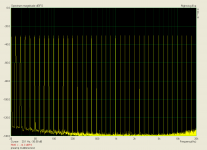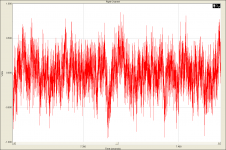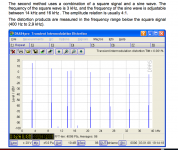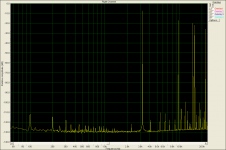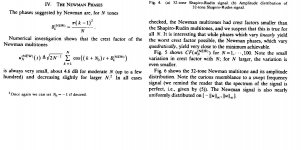It wasn't written by a newbie, it was the late Bob Pease - a guru, though not known as an audio guru:
http://www.ti.com/lit/an/snaa047/snaa047.pdf
http://www.ti.com/lit/an/snaa047/snaa047.pdf
This was not intended as an intellectual exercise in the beginning. After some output stage work I think I can reach (at least) my original goal, a discrete FET input general purpose op-amp with performance as close as possible to the JE990/OPA627/37 when used in the same circuits using almost as few transistors as the JE990 so it fits on a small card. A plus would be an all tiny SMT version.
I would also hope to build and measure a prototype.
OK. Do you have any measured data yet? Or, soon? How is it coming along?
Last edited:
I will say that after a cursory review of two patents I was kindly sent, I think that at least one aspect of linuxguru's basic approach, namely the nearly constant operating point of the main device, both current and voltage, is not covered per se.
Cool - however, it's entirely possible that the topology has been invented earlier. Hopefully, it's not the subject matter of an active patent or continuation. It's fine if it's covered by an expired patent.
Meanwhile, I was temporarily distracted by a gainclone build. I did sim Chocoholic's symmetric CCB, and it works but needs some circuit elaborations.
EDIT Sorry PMA already said that but let me add that in doing these multitone tests for years the results were always well behaved and for the most part could be predicted by simple IMD testing at an appropriate level.
I agree that multitone tests usually do not reveal much, in case that the object under test is not poorly designed. I assume we really do not need to speak about uA741, all of us knew how poor it was even 35 years ago. The multitone test on a contemporary design just copies abilities of the measuring device. I agree that CCIF IM 2-tone test may reveal more. Again, it is not difficult today to design an audio component that is very difficult to measure regarding non-linear distortions. So probably we might like to spend our efforts to parameters like high frequency PSRR, RFI immunity, immunity to HF demodulation and detection. This needs high speed design and fulfillment of HF circuits design rules. Together with suppression of LF noises by proper wiring and PCB design inside the housing. Not so easy to get and impossible to get by web discussions.
Attachments
George, the measurements are explained in post 1099
I meant the FFT at post #1107. Is it sine-square superposition? If so, what is the freq of square and sinus input and amplitude ratios?
Thank
Not so easy to get and impossible to get by web discussions.
He, he. True.
It’s good that you take a short brake from planning/soldering and drop some wise thoughts/suggestions here.
Ref. Attached screenshot
I see the noise floor becoming thicker with freq. increasing. Is it due to the accumulation of intermod products of the multitone test?
George
Ref. Attached screenshot
I see the noise floor becoming thicker with freq. increasing. Is it due to the accumulation of intermod products of the multitone test?
George
Hi George,
no. Depends on SW used, type of averaging etc. If I used another SW, you would see "thin" FFT bottom.
Regards,
Here is how that measurement works :
Hi Joachym,
yes, sometimes we may see something in a DIM/TIM test.
Regards,
Attachments
I would love to be more informed on distortion and masking etal. BUT does that mean we cant do anything except the same single tone or two tone Im test?
I posted a 100 tone 1/10 octave multitone signal (1 minute 24/96), but someone had to host it and I don't know where it is now. I also did an inverse RIAA version. It was setup to repeat at exactly 64K samples so an unwindowed 64k FFT gave exact bins with no leakage. A good sound card gave a very low noise floor in loopback.
Maybe we could revisit this and Jan could host it??
Here is an astounding claim from National Semi. I would call that settling time. What happens after an aprupt transient ? How long does the opamp need to pull the output to zero ?
That's pure Bob Pease!
I posted a 100 tone 1/10 octave multitone signal (1 minute 24/96), but someone had to host it and I don't know where it is now. I also did an inverse RIAA version. It was setup to repeat at exactly 64K samples so an unwindowed 64k FFT gave exact bins with no leakage. A good sound card gave a very low noise floor in loopback.
Maybe we could revisit this and Jan could host it??
In order to test an opamp design more thoroughly and more like what we are exposed to when listening, we need to get back to things like this ... because it seems we can hear many tones in listening to music which we cant duplicate in tests thru amps as has been pointed out here... the 'how to' part. But 100 tone would be very helpful as a pointer or marker or dot to connect. I wonder where your good work went. It could then become documented and part of a professional paper/journal. So much to do and so little time.
In the mean time can we also try showing IM data when doing sim's and measurments, please?
Thx - RNM
Last edited:
Here's a link to a typical RF type test that is commonly used.
http://www.ab4oj.com/test/docs/npr_test.pdf
In essence, you would use many tones to create the notch, or a notched white noise source.
Then you measure the noise power only in the notch. With tones, you could likely arrange them so typical IMD products would occur" in the notch"
http://www.ab4oj.com/test/docs/npr_test.pdf
In essence, you would use many tones to create the notch, or a notched white noise source.
Then you measure the noise power only in the notch. With tones, you could likely arrange them so typical IMD products would occur" in the notch"
But 100 tone would be very helpful as a pointer or marker or dot to connect.
No. Try it yourself and you will see. You have to reduce amplitude of individual harmonics to get within Vpp limits and you will approach to noise-like signal. Not enough dynamic measurement range to evaluate the result, it would be hidden in noise.
No. Try it yourself and you will see. You have to reduce amplitude of individual harmonics to get within Vpp limits and you will approach to noise-like signal. Not enough dynamic measurement range to evaluate the result, it would be hidden in noise.
There used to be a utility on the AP website, makewave.exe iirc where you could specify the components and also the crestfactor to get around these issues. The output is a table of frequencies with their amplitude and phaseshifts.
You want to specify each component such that the harmonics falls in unique freq bins so you can FFT all individual components and separate harmonics from IM components etc. It's a pretty involved process, and you end up with freqs like 34.774Hz or 12.632kHz, but it is a very powerful music-like test signal allowing extensive analysis of what exactly goes on in your amp under music-like conditions.
Edit: There's also a standardized set of 31 tones according to this protocoll called, not surprisingly, ISO31.
jan
There used to be a utility on the AP website, makewave.exe iirc where you could specify the components and also the crestfactor to get around these issues. The output is a table of frequencies with their amplitude and phaseshifts.
jan
You don't get around these issues. There is a minimum crest factor that is possible as you add tones, with lots of tones the signal is noiselike and the expected crest factor approaches 3.1 but you can not make it 1 so the result is to operate almost all the time at -10dB from full scale. Clipping just a single peak crest contaminates the noise floor dramatically.
I wrote a C program to adjust crest factor to a specified peak but usually we wanted high crest factors like 5.3 or 6.1. I never set it up to lower the crest factor to the minimum possible but with lots of tones this is intractable and I would do it iteratively.
Last edited:
This applies more to loudspeakers but it can be used for electronics too. It would require to measure at many frequencies to be useful. Anyway, usually distortion goes up with frequency and level so i still like the 19kHz-20kHz intermodulation test. "Close-3rd Order" Intermodulation distortion measurement
- Home
- Source & Line
- Analog Line Level
- Discrete Opamp Open Design
